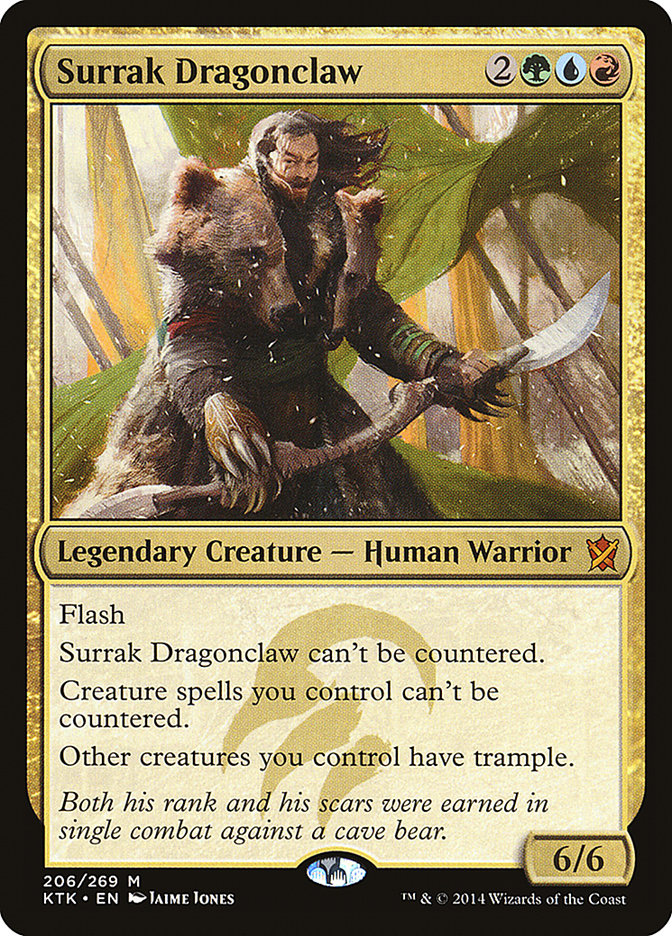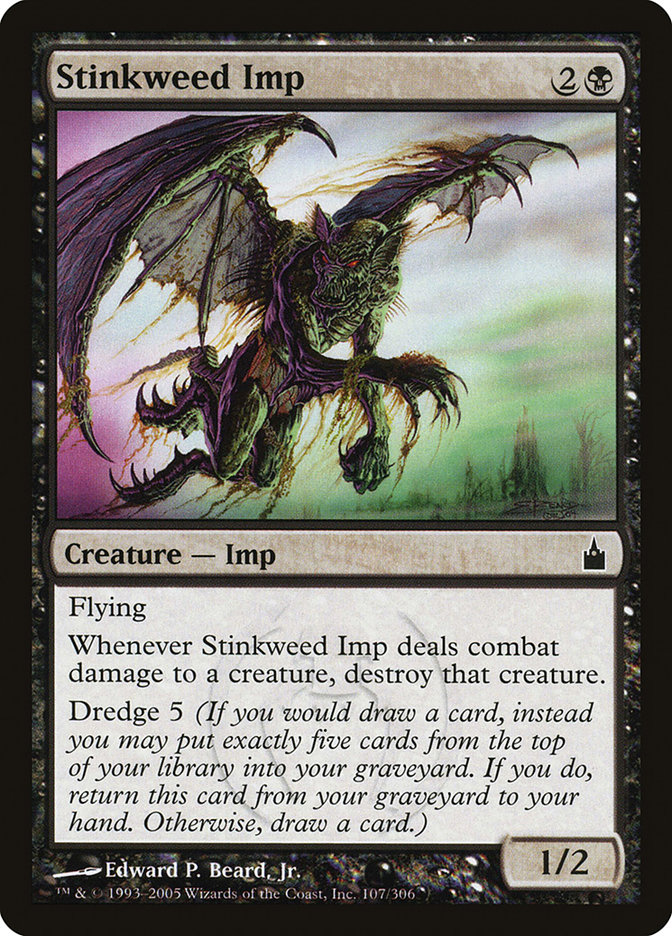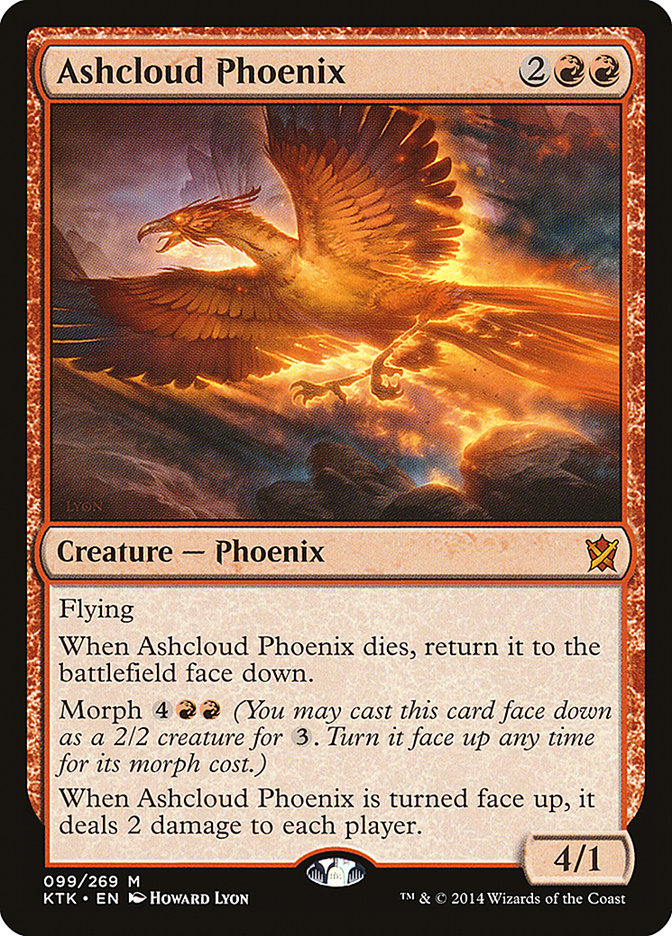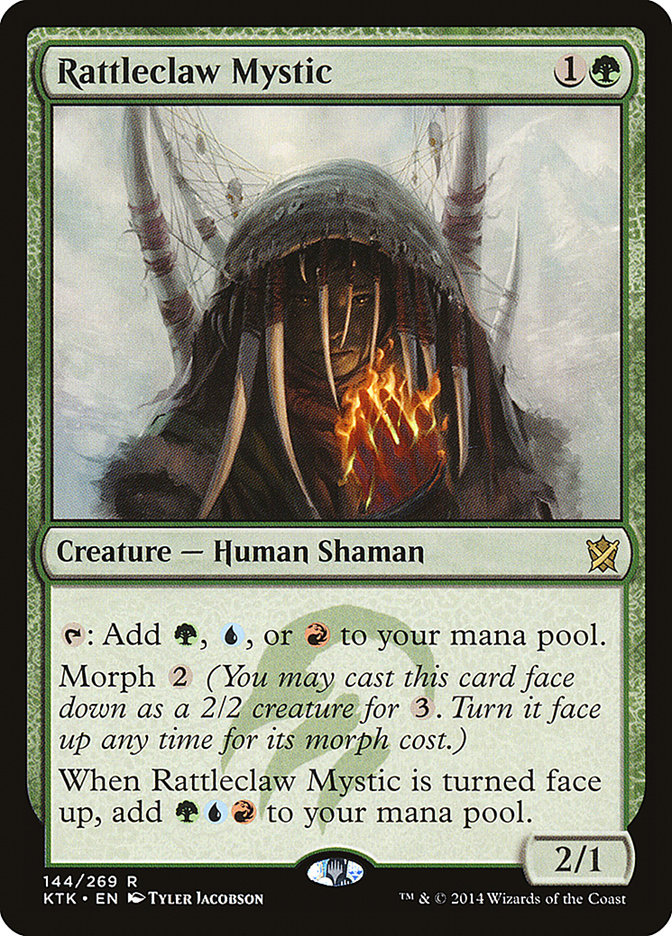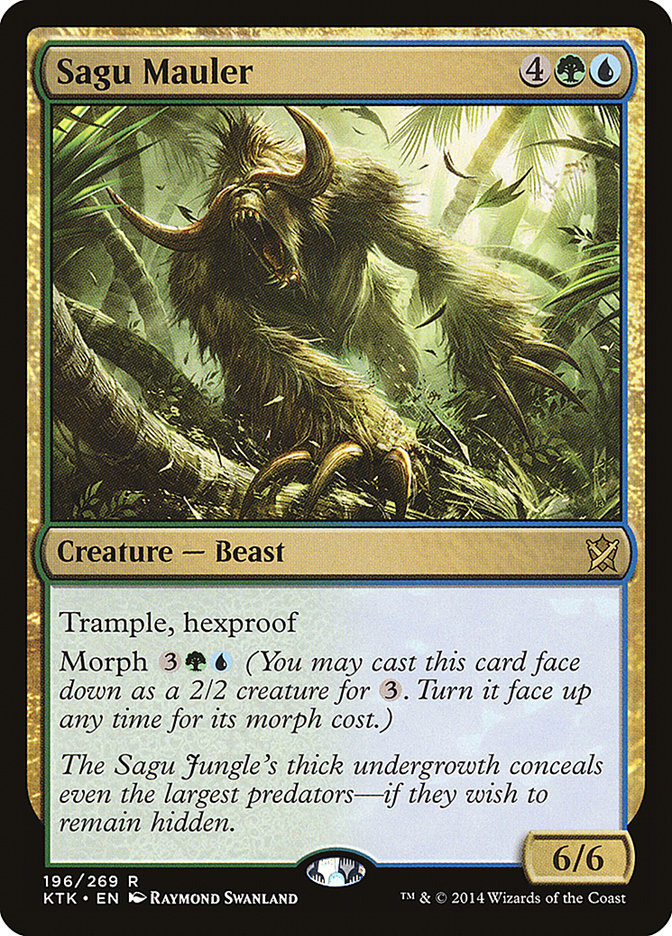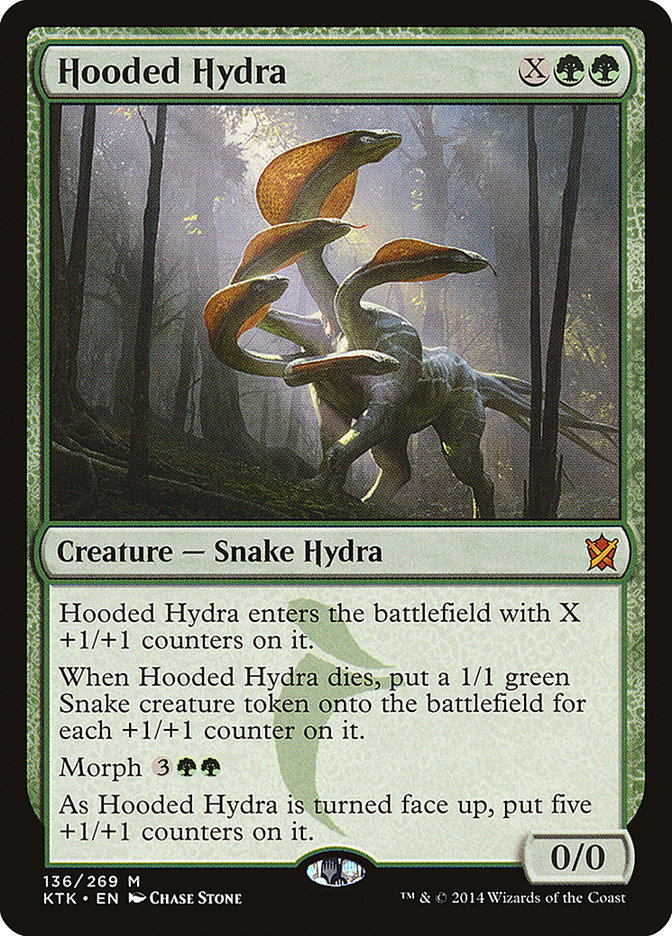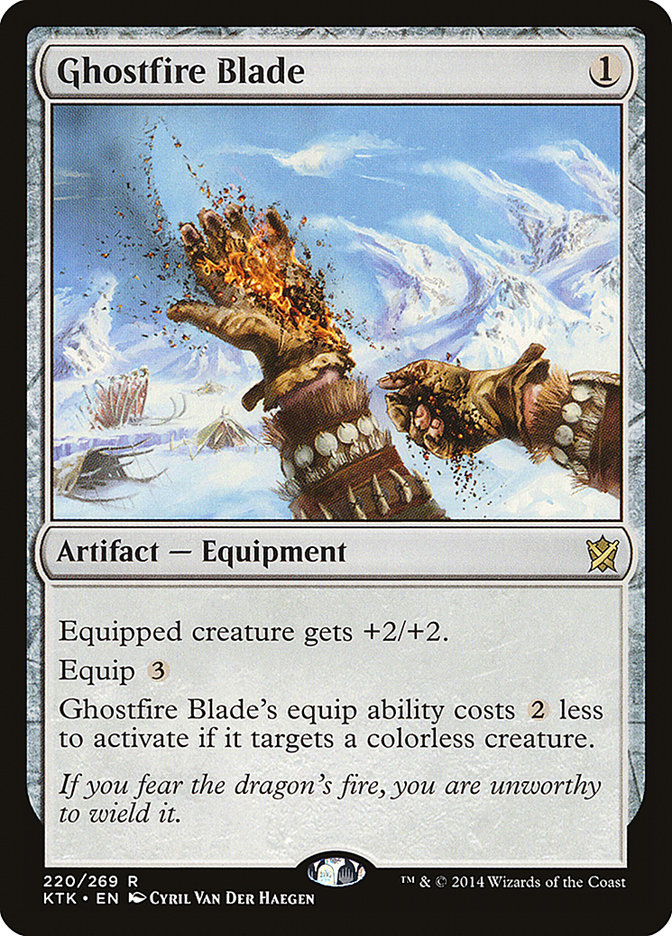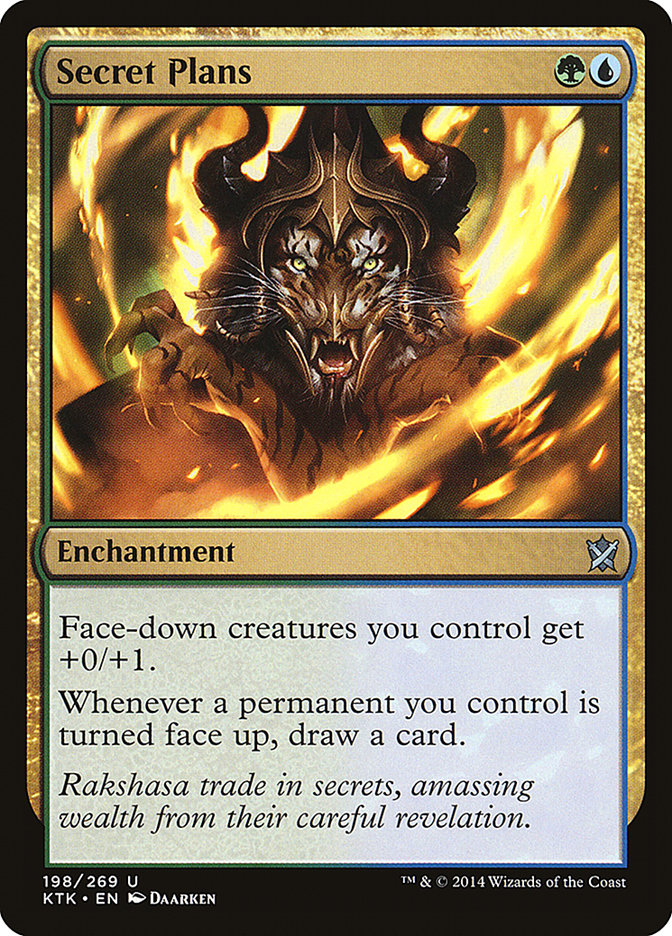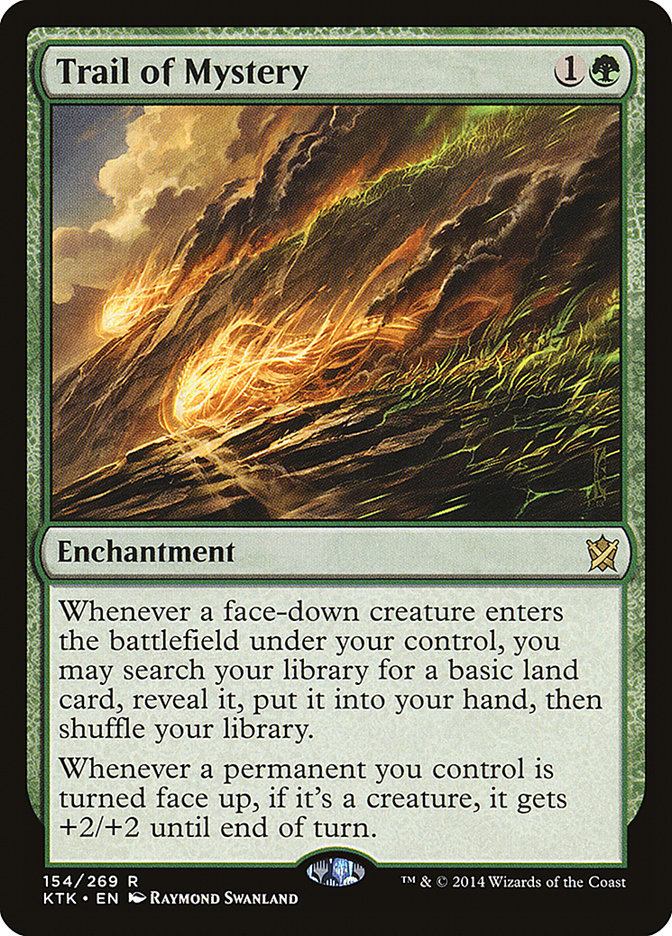Hope y’all had a good time at the Khans of Tarkir Prerelease. I had the kids last weekend, but I was able to attend a Friday midnight prerelease. I picked
Temur in the hopes of opening a sweet foil Prerelease Surrak Dragonclaw for Commander, but instead I opened a not-so-sweet foil Prerelease Trail of
Mystery. I wasn’t unhappy to have it in my Sealed deck because it’s obviously awesome in Limited with a bunch of morphs, but I don’t play foils in my
Constructed decks and it’s pretty narrow for Commander. Of course, I never once drew it in any of my Prerelease games but still managed to go 2-1 for the
night’s matches. Turns out the morphs were sweet enough to get there even without a Trail of Mystery.
I have an as yet untested theory that morphs might actually be Standard playable right now, but before you laugh and click away, hear me out.
First off, we all know that sometimes Magic mechanics are pushed for Constructed formats, and sometimes they are just for Limited play with maybe a few
rare or mythic exceptions. It might be hard to believe, but when Ravnica first came out in 2005 the Dredge mechanic was considered to be a Limited mechanic
at best. It was even considered by some to be a “bad” Limited mechanic because relying too heavily on Dredge cards could quickly exhaust your 40 card deck
so at best you’d want just a couple Dredge cards.
I initially bought into that same notion as everyone else and didn’t pay much attention to those cards. The card that I was interested in breaking was
Bloodbond March, and I was determined that I could cook up a sick rogue deck and take the Virginia 2005 State Championships by storm. Me and rogue idea man
Jay Delazier had a dream, and it involved casting Kokusho, the Evening Star and getting back a couple other copies of it with Bloodbond March and
initiating a huge, game-winning lifedrain on our opponents (this was under the old legend rule where all copies of a Legend in play immediately die if
another copy enters play).
The tricky part to this plan was to get multiple copies of Kokusho, the Evening Star in the graveyard by the time we had mana enough to cast Kokusho, and
it turned out the best way to do this was with dredge. Golgari Thug was the first creature we tried, since when it died we could put a copy of Kokusho on
top of our library to draw and cast the next turn. But we found that just having a couple dredge cards wasn’t enough to reliably fill our graveyard, so we
started playing more and more and more… until eventually we got a critical mass of dredge cards and our graveyard consistently became a crazy and powerful
resource each game. A funny thing happened along the way though. We ended up winning games with Stinkweed Imp, Necroplasm, Grave-Shell Scarab, Moldervine
Cloak, Darkblast, and Life from the Loam a lot more than we won games with Bloodbond March. In fact, Bloodbond March always seemed to end up dead in our
graveyard, and once we cut that plan from the deck and leaned more heavily on just being the best dredge deck we could be we started crushing all the other
decks in our gauntlet. We called this pile of “bad” cards NiceDraft.dec, and I vowed to play it at States that weekend. Jay was going to play it too, but
audibled into a more conventional choice at the last minute, fearing that we’d totally gone off the deep end.
I have to admit I was a little bit nervous, but I stuck to my guns and ended up cruising to Top 8. I had the ultimate brewer’s buzz, with the whole room
chatting about this crazy dredge deck that no one could figure out how to beat, and crowds gathered around my matches after about the fourth round. I wrote
about my adventures here which I’m pretty sure
was the very first strategy article ever written on dredge for Constructed Magic. It even got a shout-out in Michael Flores’ States Decks recap on
MagicTheGathering.com where he called it “one of the ugliest decks I’ve ever seen” and “genuinely… odd. Running a Stinkweed Imp engine to hold off even the
most efficient, sleek, and beautiful threats on a persistent basis, Bennie can Dredge through his deck to set up a Demonic Tutor-like availability of
graveyard options.”
Next to that paragraph is a picture of Stinkweed Imp with the caption “not just for draft anymore?” Indeed, not too long after that John Rizzo
threw some Ichorids in a Dredge shell for Extended and the cat was finally out of the bag-the Dredge mechanic was indeed not just for Draft anymore.
Now, the point of this story isn’t to suggest that morph is the next broken mechanic but rather to propose that morph this time around might be stronger
than we think it is, perhaps even Standard strong. Following is some evidence that might support this notion:
-
-The best removal spells in the format aren’t cheap. No longer do we have exceptional two mana removal spells like Doom Blade, Ultimate Price, and
Mizzium Mortars that can gain tempo advantage by taking out a creature that costs more mana. The gold standard is now Hero’s Downfall, which costs
the same as playing a creature with Morph. -
-Removal spells are precious. In the old Standard if you really wanted to kill creatures you could stuff your deck to bursting with creature
removal. In the new Standard, removal doesn’t appear to be nearly as plentiful, which means each piece of removal needs to be doled out carefully.
If you’re squaring off against two facedown 2/2 creatures and there is five mana available to turn one of them face up, which one do you hit with
Hero’s Downfall? Is it a Rattleclaw Mystic or is it a Sagu Mauler? God forbid there’s six mana available and one might be a Kheru Spellsnatcher
that could Spelljack your precious removal spell. -
-The morph support cards are really good. Secret Plans and Trail of Mystery are perfectly costed at two mana, hitting the battlefield the turn
before you start casting your morph spells. They both have two good effects that are cumulative so if you draw additional copies, they aren’t
blanks. Even Tomb of the Spirit Dragon might be decent, though not being able to produce colored mana might make it a tough sell in most builds. -
-Many of the morph creatures are perfectly respectable Magic cards when cast face up. I would not at all be embarrassed to ignore the morph text and
play Rattleclaw Mystic or Icefeather Aven on turn 2 or a Sagu Mauler on turn 6. This sort of flexibility really helps push the quality level
towards Standard viability.
One quick note about Bile Blight. At first blush it might seem that all your morph creatures would get blown away by a single Bile Blight, but here’s the
relevant part of the comprehensive rules about morph:
702.35b. To cast a card using its morph ability, turn it face down. It becomes a 2/2 face-down creature card, with no text,
no name
, no subtypes, no expansion symbol, and no mana cost.
Bile Blight looks for other targets with the same name, but thankfully our morph creatures have no name when they’re face-down. Bile Blight is a fine
removal spell that would indeed handily handle killing a morph dude and gain some tempo, but I don’t think that will be too prevalent in the new Standard.
For one thing, double black mana might not be something people are looking to do now that we’ve been infused with powerful gold cards. Also, being able to
kill four toughness creatures seems to be the hallmark of a good removal spell. That’s why some of what I’ve been reading on the Premium side seems to
suggest that Lightning Strike isn’t very good.
Okay, so let’s assume my theory that morph might be good enough for Standard right now is valid. How do we go about building it? Looking at the best morph
and support cards, playing green and blue seems like a given. Rattleclaw Mystic could give us some fixing to add red, so is adding that third color worth
it? Temur is one of the clans so we’ve got Frontier Bivouac for mana fixing. Jeering Instigator is a solid morph creature that is bound to lead to some
sweet blowouts in a creature-heavy environment, but the morph creature that really has my attention is Ashcloud Phoenix. Ironically, this card is best when not played as a morph, giving you a 4/1 flying body for four mana and when it dies, it gives you a 2/2 morph. Getting a 4/1 flier and a 2/2 ground
pounder for four mana is a pretty sweet deal, but if you get to the point of having six mana available, Ashcloud Phoenix basically becomes immortal. What’s
cool is that even though you’re not typically going to play Ashcloud Phoenix as a morph, it still plays nicely with Trail of Mystery when it dies, since
Trail of Mystery very conveniently triggers whenever a face-down creature enters the battlefield under your control rather than whenever you play a
face-down creature. Kudos to R&D for making sure those two cards work together!
So which morphs do we play? I already mentioned Rattleclaw Mystic and Icefeather Aven, and I think a full four of each is perfectly fine. I particularly
love Rattleclaw Mystic for its ability to unmorph and actually net us a mana, giving us one of each of our three colors, and then being able to tap for an
additional mana. That goes a long way towards the magic number of 5-6 mana for the morph cost of our higher impact morph creatures, or fully flips
Icefeather Aven to bounce one of our opponent’s problematic creatures or to save another one of ours. Jeering Instigator’s morph cost is also just three
mana and can lead to some sweet blowouts. I’m just playing one for now in order to keep my opponents guessing, but I might end up adding more depending on
how the metagame shakes out. Mistfire Weaver is another one with a three mana morph cost and basically provides you a counterspell against targeted
removal, and I think throwing one into the mix can stretch your opponent’s guessing game even further. Last of the one-ofs is Kheru Spellsnatcher, which I
fully expect to be a Commander staple, but I think could be quite decent in Standard too. Yes, the morph cost is expensive, but being able to effectively
counter an opponent’s spell and then be able to cast it yourself could be a huge tempo swing. Keep in mind this is any spell-Hero’s Downfall; Polukranos,
World Eater; Elspeth, Sun’s Champion. Six mana is well worth countering it and getting a copy of my own.
Last up are the two heavy hitters. Sagu Mauler provides a large body with evasion, and having hexproof on the face-up side of the card can potentially net
you some card advantage if you flip it in response to targeted removal. Playing it as a Morph lets you dodge Elspeth’s -3 ability and gives you the chance
to attack her directly, trampling over her three blockers and leaving her with just two loyalty.
Hooded Hydra won’t dodge the removal spell, but it provides resistance by leaving behind five or more 1/1 snake tokens so I like that the Hydra provides
resistance to mass removal alongside Ashcloud Phoenix.
Okay, so we’ve got a gaggle of morph creatures we want to play. How does that impact our mana curve? Basically our three mana slots are overbooked,
especially when you add in many of the morph costs being three mana. That means it’s highly unlikely we want any spells that actually cost three mana – no
Courser of Kruphix, no Temur Charm, no Goblin Rabblemaster, no Savage Knuckleblade. Also, our five and six mana slots are filled with the virtual spells we
have tied up inmMorph costs. So that means to fill out our deck we’ll want one, two, and four mana spells.
We already know we want Ashcloud Phoenix cast face up so we’ve got or four mana slots on the curve covered. For one mana Elvish Mystic seems like a no
brainer-if ever we want to have three mana available on turn 2, it’s when we’re running a morph deck! Between Wooded Foothills, Yavimaya Coast, and basic
Forests, turn 1 Elvish Mystic isn’t going to be a rare occurrence. Ghostfire Blade is an interesting consideration for one mana given it’s equip discount
on colorless creatures; it wouldn’t be all that unusual to find yourself with an extra mana lying around to slip this on a morph to give you a 4/4. Equip
Icefeather Aven while it’s face down, pay its morph cost and return an opponent’s creature to his or her hand and swing in with a 4/4 flier.
I also wanted some fast removal spells handy; if I’m fooling around with three mana 2/2 creatures, I don’t want to get beaten down to low life totals by
things like Soldier of the Pantheon, Bloodsoaked Champion, or Goblin Rabblemaster before I have a chance to stabilize. Magma Spray is cheap, efficient, and
seems like just the right spell for the job.
Since Rattleclaw Mystic and Icefeather Aven are perfectly respectable two mana spells, I’ve got that point on the curve covered, but I don’t want to
neglect the morph support spells Secret Plans or Trail of Mystery. Both are quite good, but I don’t think I want a full playset of each. I eventually
settled on five slots for those two cards, but what’s the best split? I’ve had some disagreement with a few friends regarding which card is better. Trail
of Mystery is quite good and turns all your morph cards into enhanced Borderland Rangers, which itself was a very serviceable tournament card, and the
power/toughness boost when morphs flip can be quite beneficial. I also appreciate the toughness boost on Secret Plans, which enables you to attack into or
block Courser of Kruphix, one of the power cards in our new Standard, and I very much love the card-drawing trigger when you flip a morph card. At this
point I’m leaning towards a 3/2 split in favor of Secret Plans, but that could change as I get more experience playing this deck.
Last but not least, it seems like it would be a crime if I didn’t find room for Prophet of Kruphix given we’re playing nearly mono-creatures and have need
for lots of mana. I don’t think I want a second, but a miser’s copy seems perfect. Here’s what I’ve got cooked up for Standard Morph:
Creatures (26)
- 4 Elvish Mystic
- 1 Prophet of Kruphix
- 4 Rattleclaw Mystic
- 4 Icefeather Aven
- 3 Sagu Mauler
- 1 Jeering Instigator
- 4 Ashcloud Phoenix
- 3 Hooded Hydra
- 1 Kheru Spellsnatcher
- 1 Mistfire Weaver
Lands (24)
Spells (10)

I think the trick to really understanding the benefit to playing a morph deck is to realize that the morph costs are basically spells you get to play
without costing you card slots since they’re tacked on to your creatures. Also, there’s a fuzzy but real benefit to presenting your opponent with lots of
unknown questions with each face down creature you play-sure, that morph is probably a Rattleclaw Mystic or an Icefeather Aven… but it could be a Sagu
Mauler, and there’s a small chance it could be something crazy like a Kheru Spellsnatcher. Forcing your opponent to weigh all those unknowns and
potentially make wrong decisions can give you advantages that lead to victory.
So is morph going to take Standard by storm? I don’t know, but it’s likely a lot better than we think it is, especially right now while we’re in the
shallow end of the card pool rotation. I think it’s strong enough to take down some FNMs or Game Days, and who knows? It might surprise us all. If you’ve
got any thoughts on the Standard Morph deck, or have run some playtest games already, I’d love to hear from you!
New to Commander?
If you’re just curious about the format, building your first deck, or trying to take your Commander deck up a notch, here are some handy links:
-
Commander Primer Part 1
(Why play Commander? Rules Overview, Picking your Commander) -
Commander Primer Part 2
(Mana Requirements, Randomness, Card Advantage) -
Commander Primer Part 3
(Power vs. Synergy, Griefing, Staples, Building a Doran Deck) -
Commander Starter Kits 1
(kick start your allied two-color decks for $25) -
Commander Starter Kits 2
(kick start your enemy two-color decks for $25) -
Commander Starter Kits 3
(kick start your shard three-color decks for $25)
My current Commander decks
(and links to decklists):
• Mishra, Artificer Prodigy (Possibility Storm Shenanigans)
• Yisan, the Wanderer Bard (All-in Yisan)
• Selvala, Explorer Returned (Everyone Draws Lots!)
• Grenzo, Dungeon Warden (Cleaning Out the Cellar)
• Karona, False God (God Pack)
• Doran, the Siege Tower (All My Faves in One Deck!)
• Karador, Ghost Chieftain (my Magic Online deck)
• Karador, Ghost Chieftain (Shadowborn Apostles & Demons)
• King Macar, the Gold-Cursed (GREED!)
• Niv-Mizzet, the Firemind ( Chuck’s somewhat vicious deck)
• Roon of the Hidden Realm (Mean Roon)
• Skeleton Ship (Fun with -1/-1 counters)
• Vorel of the Hull Clade (Never Trust the Simic)
Previous Commander decks currently on hiatus
:
• Anax and Cymede (Heroic Co-Commanders)
• Aurelia, the Warleader ( plus Hellkite Tyrant shenanigans)
• Borborygmos Enraged (69 land deck)
• Bruna, Light of Alabaster (Aura-centric Voltron)
• Damia, Sage of Stone ( Ice Cauldron shenanigans)
• Emmara Tandris (No Damage Tokens)
• Gahiji, Honored One (Enchantment Ga-hijinks)
• Geist of Saint Traft (Voltron-ish)
• Ghave, Guru of Spores ( Melira Combo)
• Glissa Sunseeker (death to artifacts!)
• Glissa, the Traitor ( undying artifacts!)
• Grimgrin, Corpse-Born (Necrotic Ooze Combo)
• Jeleva, Nephalia’s Scourge ( Suspension of Disbelief)
• Johan (Cat Breath of the Infinite)
• Jor Kadeen, the Prevailer (replacing Brion Stoutarm in Mo’ Myrs)
• Karona, False God (Vows of the False God)
• Lord of Tresserhorn (ZOMBIES!)
• Marath, Will of the Wild ( Wild About +1/+1 Counters)
• Melira, Sylvok Outcast ( combo killa)
• Mirko Vosk, Mind Drinker ( Outside My Comfort Zone with Milling
)
• Nefarox, Overlord of Grixis (evil and Spike-ish)
• Nicol Bolas (Kicking it Old School)
• Nylea, God of the Hunt ( Devoted to Green)
• Oloro, Ageless Ascetic (Life Gain)
• Oona, Queen of the Fae (by reader request)
• Phage the Untouchable ( actually casting Phage from Command Zone!)
• Polukranos, World Eater (Monstrous!)
-
• Progenitus (
Fist of Suns and Bringers
)
• Reaper King (Taking Advantage of the new Legend Rules)
• Riku of Two Reflections (
steal all permanents with Deadeye Navigator + Zealous Conscripts
)
• Roon of the Hidden Realm ( Strolling Through Value Town)
• Ruhan of the Fomori (lots of equipment and infinite attack steps)
• Savra, Queen of the Golgari ( Demons)
• Shattergang Brothers (Breaking Boards)
• Sigarda, Host of Herons ( Equipment-centric Voltron)
• Skullbriar, the Walking Grave ( how big can it get?)
• Sliver Overlord (Featuring the new M14 Slivers!)
• Thelon of Havenwood ( Campfire Spores)
• Varolz, the Scar-Striped (scavenging goodness)
• Vorosh, the Hunter ( proliferaTION)


